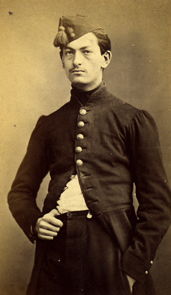Auguste Michel-Lévy facts for kids
Quick facts for kids
Auguste Michel-Lévy
|
|
|---|---|
 |
|
| Born | 7 August 1844 |
| Died | 27 September 1911 (aged 67) |
| Nationality | French |
| Scientific career | |
| Fields | Geology |
| Institutions | Geological Survey of France |
Auguste Michel-Lévy (born August 7, 1844, died September 27, 1911) was an important French geologist. He was born in Paris, France. He made big discoveries about how rocks are formed and how to study them.
Studying Rocks and Minerals
Michel-Lévy became a top official in the French mining department. He also directed the Geological Survey of France, which is like a government team that studies the Earth's rocks and land.
He was known for his work on extrusive rocks. These are rocks that form when lava or magma cools on the Earth's surface. He studied their tiny structures and how they came to be.
One of his key tools was the polarizing microscope. He was one of the first scientists to use this special microscope to identify different minerals. This microscope helps scientists see how light passes through minerals, which gives clues about what they are.
Michel-Lévy wrote many articles for science journals. He described different types of rocks, like granulite and pegmatite. He also studied the ancient volcanoes in Central France and various types of gneiss and schist rocks.
He wrote a book called "Structures et classification des roches éruptives" (1889), which means "Structures and Classification of Eruptive Rocks." He also worked closely with another scientist, Ferdinand André Fouqué. Together, they learned how to make minerals like feldspar and nepheline in a lab. They even tried to create artificial meteorites!
They published two important books: "Minéralogie micrographique: roches éruptives françaises" (1879) and "Synthése des minéraux et des roches" (1882). Michel-Lévy also worked with Alfred Lacroix on books about minerals found in rocks.
The Michel-Lévy Interference Colour Chart
Michel-Lévy was a pioneer in using something called birefringence to identify minerals. When you look at a very thin slice of a rock under a petrographic microscope, some minerals split light into two different paths. This splitting of light is called birefringence.
This effect creates special colors, known as "interference colors." Michel-Lévy created a famous chart, now called the Michel-Lévy interference colour chart. This chart helps geologists figure out what minerals are in a rock by looking at the colors they produce under the microscope. It's a very important tool for studying rocks!
Classifying Igneous Rocks
He also developed new ways to group and classify igneous rocks. These are rocks formed from cooled magma or lava. His methods looked at:
- The types of minerals in the rock.
- The texture of the rock (how big or small the mineral grains are).
- The chemical makeup of the rock.
Michel-Lévy showed that rocks with the same chemical ingredients could turn into different types of igneous rocks. This depends on the conditions when they cooled, like how fast they cooled or how much pressure they were under.


